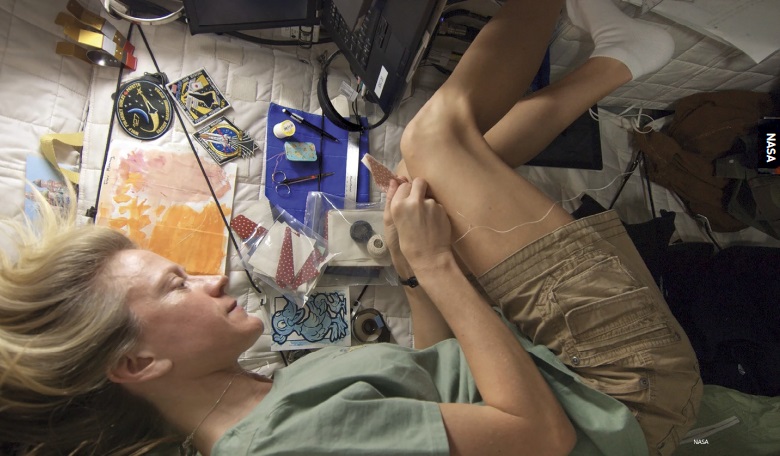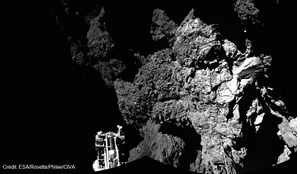As well as being an engineer and retired NASA astronaut, Karen Nyberg has a passion for art, sewing and crafting. She was the first person to quilt and sew inside a spacecraft, a challenging activity in the weightless environment. In this article we find out how Nyberg’s love for science, arts and crafts, and her desire to share with others the experience of seeing the beauty of Earth from space, led her to design space-inspired fabrics for incorporating into quilts and other crafts.
Karen Nyberg follows her passions. She knew from an early age that she wanted to be an astronaut and she pursued her goal with great focus - she has three degrees in mechanical engineering and her graduate research investigated the control of thermal neutrality in space suits. She joined the Johnson Space Center in 1991 and was selected for the NASA Astronaut Corp in 2000, participating in two missions to the International Space Station (ISS) in 2008 and 2013, accumulating 180 days in space. As a mission specialist on STS-124 she rode on was part of a crew on Space Shuttle Discovery playing its part in building the ISS by installing the Japanese laboratory. Then, as a flight engineer for Expedition 36/37 she lived aboard the Station for almost six months.
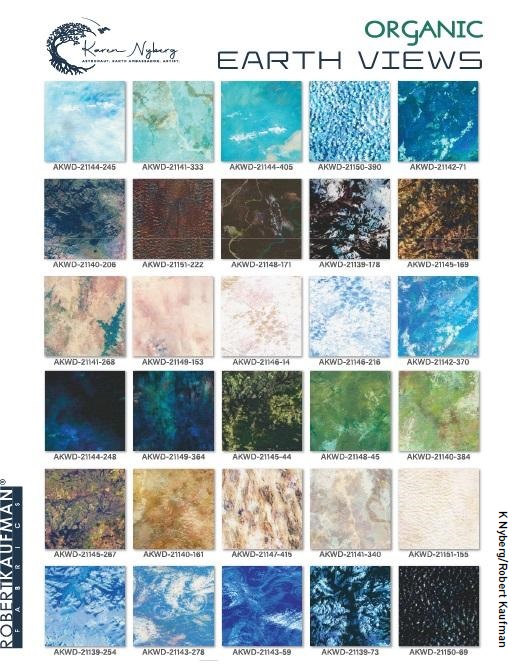 A page from Karen Nyberg’s Earth Views collection Lookbook shows sections of the photographs that provided the inspiration for the fabric designs.
A page from Karen Nyberg’s Earth Views collection Lookbook shows sections of the photographs that provided the inspiration for the fabric designs.
Passionate creativity
Nyberg’s other passion - for arts and crafts - also began as a child growing up in Minnesota, USA, in the 1970s and ‘80s. Her mother taught her how to sew and she made her first shirt at age eight. She spent most of her free childhood time drawing, painting, sewing, and crafting.
For her second mission to the ISS in 2013 she took along some sewing and quilting supplies to give her something creative to do during the down time from her role as a flight engineer. She sewed a dinosaur toy for her son, Jack, from scraps of fabric that lined the Russian food containers, stuffed with pieces from old t-shirts. The toy, resembling a Tyrannosaurus Rex, had an olive-green coloured back and a lighter green belly and the seams were stitched using blanket stitch in white thread. She shared a picture of the toy on Pinterest exclaiming “Made in space!”
It’s not the first time that astronauts have carried small stuffed toys in space. It is a custom to launch into space with a stuffed toy that serves as talisman and zero gravity indicator. Usually, a child chooses the toy, and the spacecraft commander presents it to the crew. The crew hangs it on the spacecraft’s control panel. When it begins to float, the astronauts know that they are weightless and have safely entered orbit.
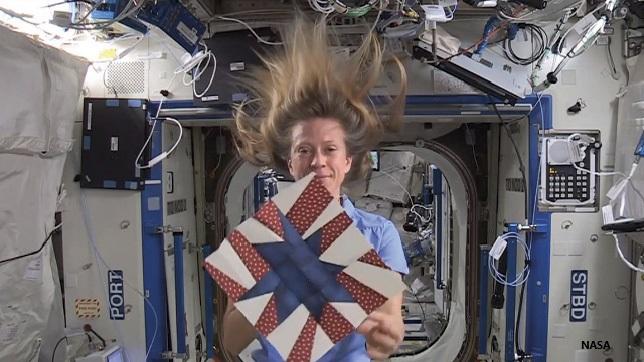 Demonstrating the use of a quilting block while on board the Space Station
Demonstrating the use of a quilting block while on board the Space Station
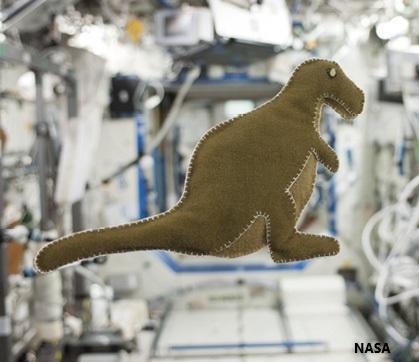 The dinosaur Karen Nyberg sewed for her son Jack during her mission.
The dinosaur Karen Nyberg sewed for her son Jack during her mission.
Star-themed quilt block
Besides the dinosaur toy, Nyberg also created a star-themed quilt block using the supplies she had brought: three pieces of fabric, scissors, white thread, and five needles with a magnetic case to hold them. She attached these supplies on a blue velcro pad so they wouldn’t float away and when she wasn’t using them, she stored them inside a zip lock bag.
To create a quilt block, a quilter must exercise exact cutting with a rotary cutter, stitching with a quarter inch (6 mm) sewing machine foot, and ironing. Since none of these things were possible in space Nyberg had to improvise. Cutting and sewing her block was rather tricky and far from perfect. She had no pins, so she taped her fabric to keep it in place for cutting, and she hand-stitched it. The result was an impressive block that raised awareness of space travel.
Quilt Block Challenge
When her block was finished, Nyberg made a video inviting quilters from around the world to participate in NASA’s Astronomical Quilt Block Challenge in cooperation with the International Quilt Festival by creating a star-themed 9.5-inch (24 cm) square to contribute to a special quilt for the 40th International Quilt Festival in Houston, Texas, in 2014.
The project drew more interest than anyone imagined, bringing together people with an interest in quilting and those with an interest in space. Quilters (some of them for the first time) from more than 30 countries around the world sent over 2400 star-themed blocks, many accompanied by letters and personal stories, showing the makers’ enthusiasm for space. A group of volunteers at NASA and Johnson Space Center pieced the blocks together and created 28 king-sized quilts which were displayed at the festival.
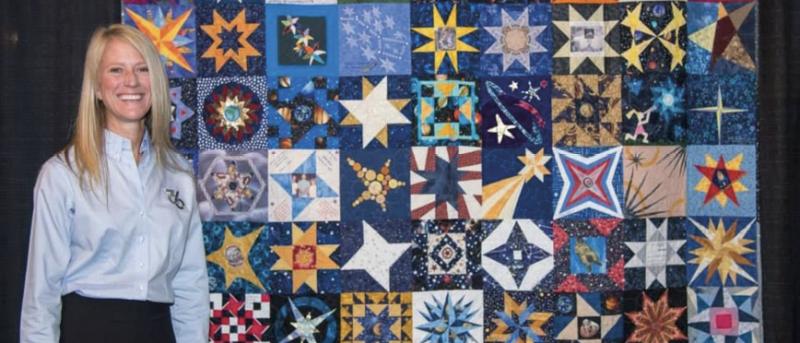 Karen Nyberg poses in front of a starry quilt at the International Quilt Festival in Houston, Texas, in 2014.
Karen Nyberg poses in front of a starry quilt at the International Quilt Festival in Houston, Texas, in 2014.
Earth Views
While aboard the ISS, Nyberg loved to photograph the breathtaking views of the Earth through the windows of the space station’s cupola: swirly ocean currents, dense forests, sandy deserts, patterned white clouds, golden sunsets, farmlands, and snowcapped mountains. Being able to capture the beauty of Earth from space fuelled her passion for art and creativity and, after retiring from NASA in 2020, she was able to pursue that passion and turn it into something more than a much-loved hobby. These images ultimately inspired her to create her first collection of organic fabric designs for quilting and other craft projects, Earth Views.
Nyberg worked with designers at Robert Kaufman Fabrics to turn the photos she took during her time on the International Space Station into images that worked well on fabric and would look good in a quilt. She selected photos that she thought would be a good representation of the many varied textures on Earth and would also capture the distinct ecosystems that make up the planet. Among the 14 textural prints (each available in several colours making a total of 30 fabrics) are squares based on Nyberg’s photos of the Andes Mountains in Chile, the Grand Canyon in the USA, the blue waters off the coast of the Bahamas and the brown-toned expanse of the Taklamakan Desert in China. Being very conscious of the issues of Earth conservation and sustainability, it was important to her that the designs were made up using 100 percent organic cotton.
The Earth Views collection was launched in 2022. To showcase the collection, Nyberg designed and created three quilts. The Endangered Animals wall hanging uses applique technique and features eight critically endangered animal species set in a circle representing Earth and the connection between the animals’ survival and the planet. The bold geometric Cupola Views pattern is a collaboration with NASA engineer and talented quilt designer, Sarah Ruiz. The design captures the essence of cupola’s central round window and six peripheral windows that offer such amazing views of the Earth. The Challenge Star quilt pattern reflects the ‘journey’ of Karen Nyberg, and others, reaching for the stars in their own ways throughout their whole lives and also the memory of the AstroQuilt Block Challenge that brought so many people together.
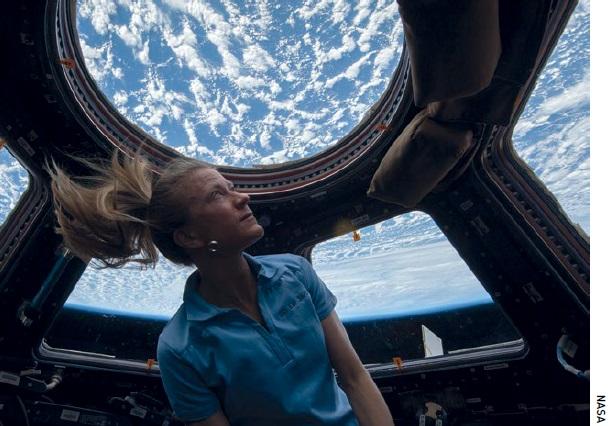 Karen Nyberg looks out of the Cupola on the ISS.
Karen Nyberg looks out of the Cupola on the ISS.
Orbital sunrise
A second fabric line, Orbital Sunrise Artisan Batiks, created in collaboration with Robert Kaufman, was launched in January 2024. The prints on these batiks depict landscapes of our solar system with stars and swirls as backgrounds: the Earth among the stars, Earth’s orbit, and topography of deserts, mountains, lakes, rivers, oceans and forests.
Nyberg uses batiks in many of her textile artworks. She loves the patterns and colours, and the creative process of wax-resist dyeing, a part of the making of batiks. She also designed this collection out of love for our beautiful but fragile planet. As an advocate of sustainable living, she wanted to make people aware of our changing Earth and to help us take actions to sustain it.
To select the colours of the batiks, Nyberg used the picture of a sunrise she watched from the ISS, one of the most beautiful and moving things she had ever experienced. It began as a white and blue line that illuminated the horizon in the pitch-black background of space. Then, it radiated red and orange as it moved across the Earth, immersing the space station in a rich gold colour. Nyberg named her fabric line after this awesome experience.
‘Orbital sunset’ is an astronomical term that describes the first rays of the sun from space. The ISS orbits the Earth at about 250 miles above its surface, and it completes one trip around the globe every 92 minutes. This means that astronauts and cosmonauts onboard the station have the chance to view several stunning sunrises and sunsets each day.
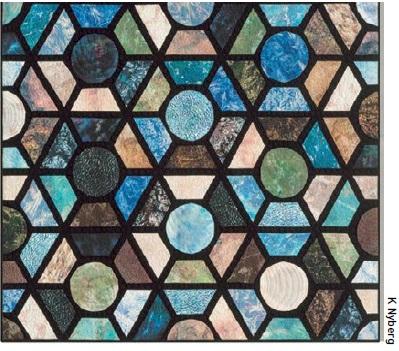 The Cupola Views quilt, 67 x 84 inches (170 x 213 cm). This design was a collaboration with NASA engineer and quilt designer, Sarah Ruiz
The Cupola Views quilt, 67 x 84 inches (170 x 213 cm). This design was a collaboration with NASA engineer and quilt designer, Sarah Ruiz
Shoot for the stars
Karen Nyberg premiered her new batiks line by making two quilts that portrayed the first women to fly in space: Soviet cosmonaut Valentina Tereshkova and American astronaut Sally Ride. She revealed the portraits to the public at the Kennedy Space Center Visitor Complex in Florida on August 17, 2023, as part of the Center’s ‘Women in Space’ summer event. That summer, the Space Center was celebrating the 40th anniversary of Ride’s first spaceflight in 1983 and the 60th anniversary of Tereshkova’s in 1963. Nyberg herself was the 50th woman to fly in space.
To create the portraits, Nyberg chose two fabrics from the Orbital Sunrise collection for the background, and small scrap fabrics. She also chose to include a simplified version of each woman’s spacecraft in the background. She ironed a fusible web onto the background fabric, and collaged together the scrap fabrics to form the images of Ride and Tereshkova. Then, she added the batting and backing fabric and machine quilted all the layers together. The result was two colourful images that were formed from the prints and shades of each fabric.
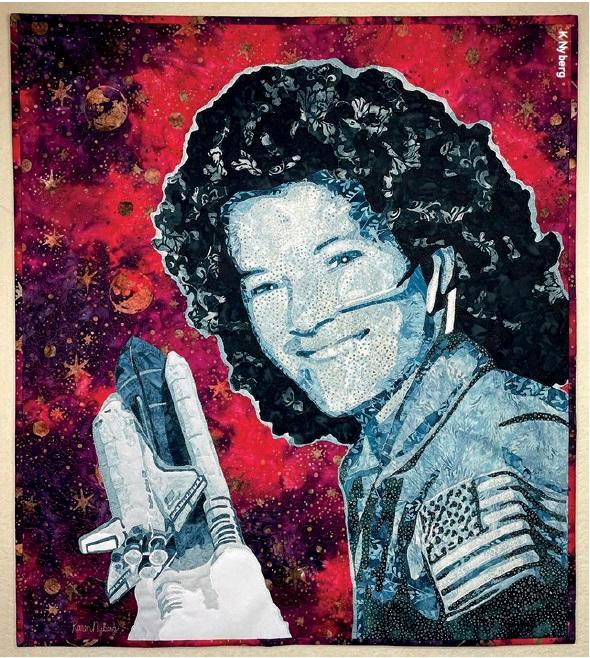 Karen Nyberg’s quilt portrait Sally Ride, the first US woman to fly into space, was revealed to the public at the Kennedy Space Center Visitor Complex in Florida on 17 August 2023, as part of the ‘Women in Space’ summer event”.
Karen Nyberg’s quilt portrait Sally Ride, the first US woman to fly into space, was revealed to the public at the Kennedy Space Center Visitor Complex in Florida on 17 August 2023, as part of the ‘Women in Space’ summer event”.
In this collection Nyberg wanted to play around with the dimensions between Earth and space. She started a long way out with Earth among the stars, then gradually zoomed in closer and closer until the textures of deserts, rivers, mountains, and lakes are visible, as they are to the crew of the ISS. She has designed and quilted four projects to showcase her Orbital Sunset line: Morning Mosaic, Celestial Blooms, Stellar Horizon, and Stellar Horizon Pillow.
While living in space, Karen Nyberg gained a profound understanding of the interconnectedness of life and our planet. From space, the Earth is very beautiful with no boundaries and no borders and it is home to all of us and we need to protect it. She hopes that by putting her photos into fabric form that can be used for creating quilts and textile artworks she can help people to appreciate the fragility, beauty and importance of Planet Earth to us all.
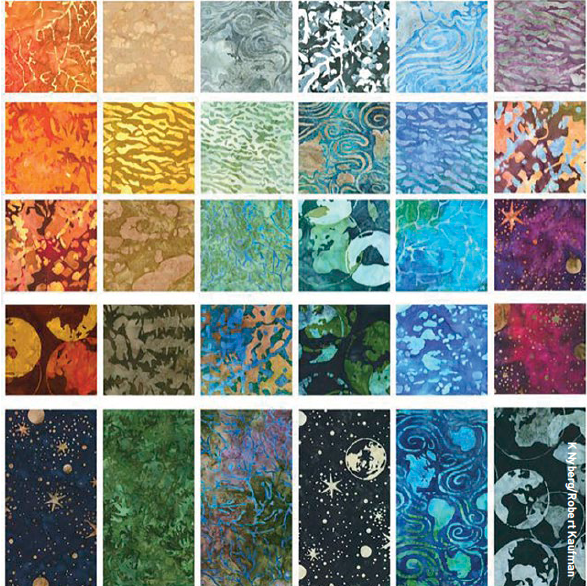 The second range of fabrics to come from Karen Nyberg’s ISS photographs is the Orbital Sunrise Artisan Batiks collection.
The second range of fabrics to come from Karen Nyberg’s ISS photographs is the Orbital Sunrise Artisan Batiks collection.
About the author
Harikleia Sirmans is a Librarian and NACO Cataloguer at Valdosta State University, USA, and owner of Grecian Needle, where she produces clothing and fabric arts. She has published several sewing and fibre-related articles on the Piecework magazine website, Textile Society of America, The Medium, and All Free Sewing. She has also translated two Greek novels, and indexed four film books. She holds an MA in Library and Information Science, and a BA in English: Language and Writing, both from Valdosta State University. She also studied Pattern Cutting at the London Centre for Fashion Studies. She has won the Valdosta Awards Program Best Dressmaker award three times.





